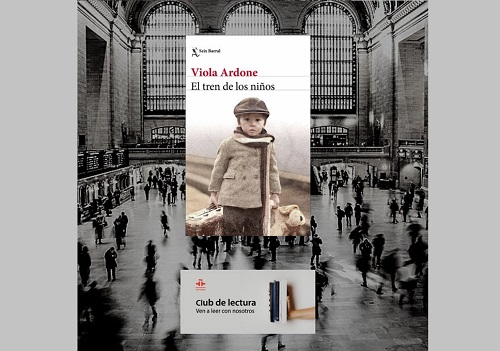Blog del Instituto Cervantes de Dublín
Torre Martello
‘El tren de los niños’: La historia olvidada de la posguerra italiana | The forgotten story of the Italian postwar

“El tren de los niños” fue una de las sensaciones editoriales más inesperadas del año 2019 en el panomara editorial italiano. Se trata de un conmovedor relato en torno al traslado al norte de Italia de miles de niños debido a la pobreza y la miseria que marcó la vida en ciudades como Nápoles tras la Segunda Guerra Mundial. Aunque la historia de la posguerra alemana es bien conocida, esta novela arroja luz sobre la situación vivida por la generación de niños de la posguerra italiana y el dilema al que se enfrentaron sus padres: mantenerles en sus barrios empobrecidos o enviarles a otra parte del país para ofrecerles una mejor oportunidad. La novela de Viola Ardone abre una ventana hacia una época oscura del pasado italiano a través de la historia de la separación forzosa de un niño (Amerigo Speranza), de su familiay de su incapacidad para entender esta situación.
En cuanto al contexto histórico, Ardone logra construir una imagen sólida de la desesperación que vivía diariamente la gente del sur de Italia. La trama de la novela nos permite comprender la mentalidad de estos padres, que asumían la imposibilidad de escapar de su estado de pobreza y la única opción de enviar a sus hijos al norte para poder garantizarles un mejor futuro. Las reflexiones del propio Amerigo y de los adultos en cuanto a la amenaza del hambre, nos permiten entender mejor la brecha entre el norte y el sur de Italia y las medidas a las que recurrían para evitar caer en la extrema pobreza.
Además del análisis de las condiciones de vida, la novela nos relata la solidaridad y el compromiso de la clase baja para vencer los desafíos a los que tenían que hacer frente. A través de la mirada del protagonista, la autora refleja la verdadera solidaridad entre los vecinos de Nápoles durante esos tiempos difíciles, así como los esfuerzos conjuntos de las madres para tratar de liberar a sus hijos de la desolación de la posguerra. Al principio de la novela se nos presenta la figura de Maddalena Criscuolo y su iniciativa para crear un mejor futuro tras la derrota de los fascistas al término de la Segunda Guerra Mundial. En este capítulo, se nos ofrece una perspectiva sobre la construcción de una red de solidaridad y los esfuerzos colectivos para ayudarse entre sí.
Tal y como han destacado muchos críticos, el aspecto más relevante de esta novela es la perspectiva que nos brinda nuestro protagonista joven, Amerigo, y sus observaciones y sentimientos sobre la realidad que le rodea. Gracias a la situación vulnerable en la que se encuentra y a sus esfuerzos por entender porqué se ve forzado a abandonar su casa, esta novela ofrece un testimonio de la experiencia vivida por estos niños y sus familias (tanto de acogida como naturales). La mirada inocente de Amerigo y su lucha por comprender la realidad arroja luz sobre los efectos sociales y emocionales provocados por las condiciones de pobreza generadas en esta época de posguerra.
Texto de Philip McGuinness
‘El tren de los niños’ was one of the most unexpected editorial success stories of 2019 owing to its moving representation of the migration of thousands of Italian children on the part of the Italian Communist Party from the south to the north of Italy arising from the poverty and destitution that characterised life in cities like Naples after the end of the Second World War. Whilst the story of Post-War Germany is well-known, this novel offers an important perspective on the lived experience of a generation of young Italians and the dilemma faced by their parents between keeping them in their impoverished communities or sending them to far-flung parts of the country in an effort to secure them a better future. In this sense, Ardone’s novel opens a window to a dark chapter of Italy’s past through the story of a child’s separation from his family and his inability to understand why he finds himself in such a horrendous situation.
With regards to the historical context, Ardone constructs a powerful image of the daily desperation endured by Italy’s underclass during this period. In the case of this novel, our attention is focused on the attitudes of the parents, mostly mothers, and their conviction that they are condemned to a life of poverty and that there is no other solution available to them then to send their children away to guarantee them a better future. As the protagonist’s observations on the adults’ reflections on the threat of hunger, we come to understand the reality of the traditional gap in living standards between the north and south and the measures to which Italy’s poorer classes resorted to avoid extreme poverty.
As well as drawing our attention to the poverty and misery that characterised life in the South during this period, we also learn of the solidarity of the working classes and their shared commitment to overcoming the common challenges that they faced. Through the perspective of the young protagonist, Amerigo, Ardone reflects the flourishing of solidarity amongst the residents of Naples and more specifically, the joint efforts of the mothers and their shared willingness to free their children from the poverty to which they had been subjected in post-war Italy. At the start of the novel, we learn about the case of Maddalena Criscuolo and her hope for a better future for Italy’s children after having struggled to overcome the threat of Fascism during the second world war. In this particular chapter, the author offers us an insight into the formation of a network of mothers focused on helping one another as they struggled with the decision as to what to do to best protect their children during this period.
As many critics have outlined, the most interesting element of this novel from a historical perspective is the point of view of the young protagonist, Amerigo, and his observations on the world around him as well as his feeling through his entire experience having found out about his mother’s decision to send him away to live with a new family. As a result of Amerigo’s vulnerable situation and his difficulties in understanding why he has been forced to leave his home, this novel provides a significant image of the true experience of the poorer classes through its insights into the perspectives of different members of the community on their lived realities. In this sense, the intuitive perspective of the young child allows us to understand the social and emotional effects of war and in this case, highlights the different challenges faced by the Italian people about which we have traditionally known so little.
Text by Philip McGuinness



